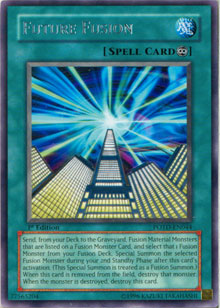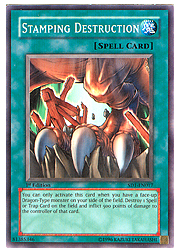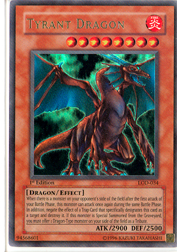I always have a couple of Top 8 decks from Shonen Jump Championships kicking around in my testing gauntlet. As a reporter, I need to know how to play those decks so that I can discuss them on the fly in tournament coverage, and nothing can substitute for real play experience. However, what I really enjoy playing are theme decks, or decks that use strange strategies or synergies to pull off unexpected wins. It’s not just a personal challenge or a source of entertainment for me: the idea of playing the same deck everyone else is and simply relying on “playing it better” than the competition leaves you wide open to bad luck.
I play theme decks seriously, which means that any creative deck making it into my gauntlet has to be decent. It’s fine to play a non-mainstream deck simply because you like Spellcasters or Thunder monsters, but that’s not what I look for when I’m designing a new deck. Instead, I try to figure out the specialized abilities that a theme can offer: in order for me to play something new, it needs to possess traits I just can’t get anywhere else.
In short, I only play a theme deck if there’s a reason to do so.
That’s the problem that’s faced Dragons all these years: their unique tricks simply weren’t good enough compared to those offered by Warriors, Machines, Zombies, or other monster types. Sure, dropping two Blue-Eyes White Dragon cards with The Flute of Summoning Dragon and Lord of D. was a game-winning move, but it was also a four-card combo that’s virtually impossible to pull off. Lord of D. himself was just too easy to run over, so his ban on targeting was rarely an issue for the opponent. King Dragun required the use of less-than-optimal Fusion materials, and so on. Even potentially great cards like Tyrant Dragon just weren’t enough to fuel an entire deck type.
The release of Five-Headed Dragon* changes all that. Now, Dragons have a mid- and late game KO card that can manipulate tempo, take down even the mightiest of Cyber-Stein’s buddies, and wipe out many an opponent in a single shot. Are Dragons broken-crazy-good? Certainly not. However, for the first time since the early days of the Yu-Gi-Oh! TCG, they’re at least a justifiable choice for local competition. Just in case you haven’t seen it, here’s what the Dragon does:
Five-Headed Dragon
DARK Level 12 ATK 5000 DEF 5000
Dragon / Fusion / Effect
The Fusion Material Monsters for this card are any 5 Dragon-Type monsters. This monster cannot be Special Summoned except by Fusion Summon. This card does not take any Battle Damage (so it cannot be destroyed) when battling an EARTH, WATER, FIRE, WIND, or DARK monster. (Battle Damage is still inflicted to players.)
I’ve been itching to run Five-Headed Dragon ever since I learned of its release, and while there are a lot of ways it can be used, I’m going to go with the most simplistic. The deck aims to swing with Five-Headed Dragon once or twice for game. That means I need to accomplish two goals:
1—Get the Dragon on the field.
2—Simplify the duel so that once he gets out, he’ll have a relatively clear path to my opponent’s life points. In addition, limiting the number of cards my opponent has will limit his or her access to answers like Smashing Ground and Sakuretsu Armor. Let’s look at how I plan to accomplish each of those goals.
Getting Five-Headed Dragon into Play
 There are two relatively easy ways to properly Fusion summon Five-Headed Dragon. The first is Future Fusion, which will let me pick and choose five Dragons from my deck in order to bring out Five-Headed. The second is Dragon’s Mirror, a specialized Fusion card that lets me remove monsters from my field and graveyard to act as Fusion materials for a Dragon-type Fusion summon.
There are two relatively easy ways to properly Fusion summon Five-Headed Dragon. The first is Future Fusion, which will let me pick and choose five Dragons from my deck in order to bring out Five-Headed. The second is Dragon’s Mirror, a specialized Fusion card that lets me remove monsters from my field and graveyard to act as Fusion materials for a Dragon-type Fusion summon.
On one hand, I could run one copy of Future Fusion and use it to bring out Five-Headed Dragon in the early game. That would then dump five Dragons into my graveyard for later use with Dragon’s Mirror, a neat little combo that could see me getting out two Dragons as early as turn 1. However, Future Fusion presents me with some unfortunate complications. First, it works like Call of the Haunted and Premature Burial—if it’s destroyed, I lose my Dragon. More importantly, although it’s very good at bringing out a Fusion early on, it becomes a dead draw the moment I dip below five Dragons remaining in my deck. Even more important than that, if I bring out Five-Headed Dragon in the early game it’s pretty easy for my opponent to have at least one answer to it: Smashing Ground, Exiled Force, Brain Control, Bottomless Trap Hole, Sakuretsu Armor . . . all things I want to force my opponent to play out before I drop the Dragon.
Dragon’s Mirror is the consistent bet for what I’m trying to accomplish. One of the cool things about Dragons is that they’re one of only two monster types with a six-link chain of recruiters: you can summon Masked Dragon, run through your extra two copies, and then use the last one to special summon Troop Dragon. That allows you to block up to six attacks and stack six Dragons into your graveyard—more than enough for Five-Headed Dragon. If the opponent wants to break your string of recruiters with anything other than Zaborg the Thunder Monarch or D. D. Warrior Lady, they’ll have to use cards like Smashing Ground—cards we want them to waste anyway.
A contingent of Dragon-type recruiters and a pair of Dragon’s Mirror will be the perfect fuel for my strategy.
Creating a Winning Situation
This deck wants to simplify the duel as quickly as possible, because doing so gives it a lot of advantages. First, it reduces the number of monster destruction effects my opponent will have on hand, keeping my big hitters safe. Second, it ensures that when Five-Headed Dragon attacks, it’ll have a better chance of swinging for damage. As a bonus, if I can simplify the game really early I’ll keep my Masked Dragon cards and Troop Dragon cards on the field. It’s great if they draw out monster removal, but I also like controlling the game and keeping the opponent’s attackers from smacking me around.
There are two common methods of simplifying a duel. The first is the establishment of a fast tempo. If both players are exchanging cards quickly (through both battle and the expenditure of cards for effects), then that takes cards out of the equation over the long term. In the short term, the use of cards that can force trades with my opponent will also reduce the number of cards we’re both holding.
To that end, Heavy Storm, Mystical Space Typhoon, Nobleman of Crossout, and two Smashing Ground cards are a must. Each is proactive and high in utility. While Smashing Ground can be a dead card against an opponent who likes to set lots of monsters, we’ll be using some tricks to force him or her out of that shell. From there we can force more trades with Ring of Destruction, Mirror Force, Torrential Tribute, and a single copy of Brain Control. The latter can draw out Sakuretsu Armor or Mirror Force, or it can allow a clear attack followed up by an immediate tribute of the opponent’s monster. Either way, cards leave the field and we’re left in a favorable position.
 Since this happens to be a Dragon deck, we also have access to one of the coolest card-for-card trades ever: Stamping Destruction. This will help keep the field clear for big attacks, create duel simplification, and generate some extra damage to help ensure that Five-Headed Dragon’s first attack is the only one it needs to make.
Since this happens to be a Dragon deck, we also have access to one of the coolest card-for-card trades ever: Stamping Destruction. This will help keep the field clear for big attacks, create duel simplification, and generate some extra damage to help ensure that Five-Headed Dragon’s first attack is the only one it needs to make.
So we’ve got plenty of card-for-card trades to make the game smaller. How about cards that force the opponent to play aggressively and trade monsters? Luckily for us, Dragons have one of the best monsters for creating these kinds of conditions. Spear Dragon can take out plenty of defenders to help us remove cards from the field, while dealing damage and furthering our long-term goal of bringing the opponent into Five-Head Dragon’s KO range. Also, since it turns to defense position, it tends to bait out attacks from the opponent, meaning you’ll be able to attack back for more damage (and another card) on the following turn. You’ll lose Spear Dragon in the process but, remember, this deck wants Dragons in the graveyard anyway. We’ve also got four traps that can protect Spear Dragon when it’s attacked, plus Book of Moon, so every time the opponent makes an aggressive move we’ll usually have options. That’s especially valuable if the monster you hit with Spear Dragon was a recruiter.
The Decklist
So with a great deal of the infrastructure laid out, here’s the build I settled on:
Monsters: 20
1 Tyrant Dragon
3 Cyber Dragon
3 Masked Dragon
3 Troop Dragon
3 Spear Dragon
1 Twin-Headed Behemoth
1 Breaker the Magical Warrior
1 Sangan
1 D. D. Warrior Lady
1 D. D. Assailant
1 Magician of Faith
1 Treeborn Frog
Spells: 13
1 Graceful Charity
1 Heavy Storm
1 Mystical Space Typhoon
1 Nobleman of Crossout
1 Confiscation
1 Book of Moon
2 Smashing Ground
2 Dragon's Mirror
2 Stamping Destruction
1 Brain Control
Spells: 6
1 Call of the Haunted
1 Ring of Destruction
1 Mirror Force
1 Torrential Tribute
2 Sakuretsu Armor
Fusion:
3 Five-Headed Dragon
 Like Stamping Destruction, Tyrant Dragon is one of the few things Dragons really had going for them before the release of Five-Headed Dragon. Sakuretsu Armor is still the monster removal trap of choice in most metagames, and buried in Tyrant Dragon’s five lines of effect text is a sentence that basically reads, “Negate Ring of Destruction and Sakuretsu Armor when they target this guy.” He can also attack twice, as long as he’s hitting monsters both times, so he really punishes recruiters. If he hits two Mystic Tomato cards, the opponent loses 1500 life points for each attack in order to maintain field presence. Brain Control, Treeborn Frog, and Twin-Headed Behemoth (which was an auto-in anyway, simply because it’s one of the best Dragons ever printed) make it easier to tribute summon.
Like Stamping Destruction, Tyrant Dragon is one of the few things Dragons really had going for them before the release of Five-Headed Dragon. Sakuretsu Armor is still the monster removal trap of choice in most metagames, and buried in Tyrant Dragon’s five lines of effect text is a sentence that basically reads, “Negate Ring of Destruction and Sakuretsu Armor when they target this guy.” He can also attack twice, as long as he’s hitting monsters both times, so he really punishes recruiters. If he hits two Mystic Tomato cards, the opponent loses 1500 life points for each attack in order to maintain field presence. Brain Control, Treeborn Frog, and Twin-Headed Behemoth (which was an auto-in anyway, simply because it’s one of the best Dragons ever printed) make it easier to tribute summon.
Cyber Dragon helps out in that respect as well, and while it’s not a true Dragon type, it does fill an important role here. It’s a threatening piece of field presence that forces the opponent to act, drawing out monster removal to protect Five-Headed Dragon later on. It lets this deck come back quickly when the opponent commits removal to one of our recruiters, and increases the impact of Brain Control.
Breaker the Magical Warrior brings this deck to a total of five pieces of spell and trap destruction, and Magician of Faith can let us reuse a card-for-card trade spell or Dragon’s Mirror. It’s especially good if Confiscation happens to strip you of Mirror early on. D. D. Warrior Lady and D. D. Assailant are both here because each usually necessitates the loss of a card from your opponent, adding to this deck’s ability to force simplification.
Call of the Haunted is particularly interesting. It’s played here over Premature Burial for two reasons. First, it’s an insurance policy when you want to attack with D. D. Assailant, Cyber Dragon, or Spear Dragon. It keeps the deck’s aggressive options open. Second, Tyrant Dragon negates and destroys Call of the Haunted when it’s special summoned by it, meaning that Call goes to the graveyard and Tyrant stays on the field. That ensures that Mystical Space Typhoon or Heavy Storm won’t end in you losing your Tyrant.
This deck usually wants to start playing conservatively, a rarity in this format. Stick-and-jab attacks mixed with a lot of field control can help you maintain field presence and stack Dragons into the graveyard while still dealing damage, and playing the early game that way takes a bit of skill. Twin-Headed Behemoth and Treeborn Frog can’t be praised enough. They’re fabulous decoys in the face of Zaborg the Thunder Monarch, and each maintains defensive field presence.
The mid-game is where things usually get nasty. Play aggressively in order to draw out cards from the opponent, and don’t fret if both of you wind up topdecking. The best topdeck the average opponent can muster is Cyber Dragon, while yours is Dragon’s Mirror. Needless to say, your best draw trumps the opponent’s. This deck doesn’t take a ton of practice to use, and can be played competently to victories in local-level tournaments provided you stay aware of your options at all times. The only thing you need to look out for is Hydrogeddon: Spear Dragon, Treeborn, Behemoth, and your recruiters all make tasty targets for Hydros. Just be careful to conserve your trap-based monster removal.
The cool thing about this deck is that while it’s a basic build, you can quickly convert it into several more complicated variants. Add another Dragon’s Mirror and you could support Return from the Different Dimension or Dimension Fusion, bringing back 1900 ATK piercers to swing into a loaded field. Add Thunder Dragon to get Dragons into the graveyard faster, and you’ll enable the use of cards like Phoenix Wing Wind Blast and Lightning Vortex. The latter is especially good considering this deck’s issues with Hydrogeddon. You could even take the path I opted to avoid, using Future Fusion and rebalancing the deck’s support cards to focus more on the early game. Even if you don’t want to bring out Five-Headed Dragon with Future Fusion, you can always drop it for Cyber End Dragon or Cyber Twin Dragon.
Dragon fans rejoice because, no matter what variant you choose to build, you now have strong reasons to play your favorite monster type! Stamping Destruction and Tyrant Dragon are both well suited to the current environment, and with Five-Headed Dragon leading the charge, you’ve got exactly what you need to compete. Build it and test it out yourself!
—Jason Grabher-Meyer
*Remember, the Dinosaur’s Rage Special Set is a limited production item. If you want to pick up a Five-Headed Dragon or two yourself, be sure to hit your local hobby store or Wal-Mart as soon as possible.